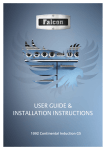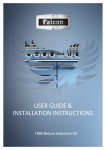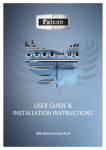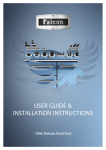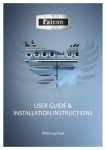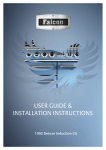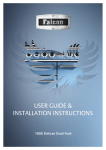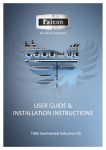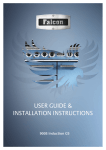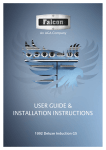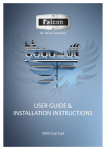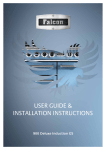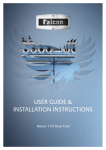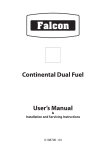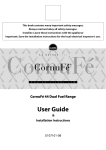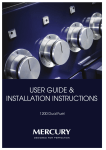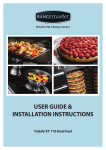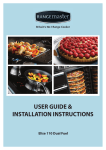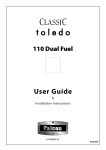Download Falcon 1092 Continental
Transcript
USER GUIDE & INSTALLATION INSTRUCTIONS 1092 Continental Dual Fuel SLOW BAKED LEG OF LAMB METHOD 1. Preheat the oven to 220 ¡C (for a conventional oven), 200 ¡C (for a fan oven) or gas mark 7. 2.Pull the small sprigs off the rosemary branches and set aside with the garlic. 2. Using the tip of a paring knife, make up to 20 well-spaced cuts into the flesh of the lamb, about 2.5 cm inch deep. Divide the rosemary sprigs, garlic and anchovies and push down into the cuts. Place the leg on a large roasting tin and pour over the oil, massaging it all over the joint. Season well with salt and pepper and pour the wine and 250 ml water into the tin. 3. Put into the oven and sear for 15 minutes, then turn the temperature right down to 130 ¡C (conventional oven), 110 ¡C (fan oven) or gas mark 1 and roast for 4Ð5 hours, basting every 30 minutes or so. Basting frequently helps to keep the meat moist and encourages the build up of a good glaze on the outside. Add more liquid (wine or water) if the tin looks dry Ð there should always be liquid in the tin throughout this cooking process. INGREDIENTS ¥ 2Ð3 large sprigs of rosemary ¥ 4 large garlic cloves cut in half lengthways ¥ 1.8 kg leg of lamb ¥ 8 good quality anchovy fillets, halved ¥ 100 ml olive oil ¥ 250 ml dry red wine ¥ Maldon salt and freshly ground black pepper 4. The meat is ready when it is starts to fall off the bone, at which point it should have a core temperature of 90 ¡C. Remove from the oven, transfer to a warmed carving dish, cover loosely with foil and leave to rest in a warm place for 30Ð45 minutes before carving. 5. Pour the juices from the tin into a tall hi-ball glass and allow to settle. Spoon the fat from the top of the glass. There should be enough sticky, reduced juices for an intense gravy hit Ð if not, pour the juices you have back into the roasting tin and put it over the heat, pour in a splash of water or wine and deglaze the tin scraping up all the sticky bits from the base. Boil fast until syrupy, taste and correct the seasoning. RASPBERRY SOUFFLƒÉ METHOD 1. For the soufflŽ, press the raspberries through a fine sieve to produce 180 g of purŽe. Put this into a heavybottomed pan, add the lemon juice and reduce down to a thick jam, stirring from time to time and being careful not let it catch and burn. 2. Put 45 g of the sugar in a separate pan. Melt it and then boil until it becomes a thick syrup (121 ¡C on a sugar thermometer). To test without a thermometer, dip a teaspoon into the syrup and then dip quickly into cold water. You should be able to roll the cooling syrup into a ball between your fingers. Be careful as the syrup is extremely hot. When it has reached the right point, stir the hot syrup into the raspberry jam. 3. Mix the framboise and cornflour together and stir into the jam over the heat. Turn the jam into a small bowl, sprinkle the surface with icing sugar and cover with cling film. INGREDIENTS ¥ 400 g raspberries ¥ 1 tbsp lemon juice ¥ 100 g caster sugar ¥ 2 tsp cr�me de framboise ¥ 1 tsp cornflour ¥ 180 g egg whites (about 6) ¥ Pinch of cream of tartar or a squeeze of lemon juice ¥ Icing sugar for dusting 4. Preheat the oven (not grill) to 180 ¡C shelf level 2 (conventional oven), 160 ¡C (fan oven) or gas mark 4 centre shelf. 5. Whisk the egg whites with the cream of tartar until you can form soft peaks, then fold in the remaining caster sugar. Lightly fold the whites into the jam, leaving thin traces of white visible in the mixture. 6. Spoon into four large buttered and sugared ramekins, place these on a baking tray and bake for 10 minutes. 7. Dust with icing sugar. Contents 1. Before You Start... 1 Important!1 Installation and Maintenance 1 Peculiar Smells 1 If You Smell Gas 1 Ventilation1 Personal Safety 1 Cooker Care 2 3. 15 7.Installation 17 Dear Installer 17 Safety Requirements and Regulations 17 Provision of Ventilation 17 Location of Cooker 18 Conversion18 Cleaning2 2. Cooker Overview 6.Troubleshooting 3 Positioning the Cooker 19 Moving the Cooker 19 Fitting a Stability Bracket or Chain 20 20 21 Hotplate Burners 3 Wok Cradle 4 Repositioning the Cooker Following Connection The Ovens 5 Conversion to Another Gas Accessories8 Levelling21 Storage9 Gas Connection 21 Electrical Connection 22 Final Checks 22 Final Fitting 23 Customer Care 23 Cooking Tips 10 Cooking with a Multi-function Oven 10 General Oven Tips 10 4. Cooking Table 11 5. Cleaning Your Cooker 12 Injectors24 Essential Information 12 Tap Adjustment 24 Daily Care 12 Reassembling to Liquid Propane Gas 25 Cleaning for Spills 12 Stick on Label 25 Pressure Testing 25 8. Conversion to LP Gas Cooktop Burners12 Main Top 13 Ovens13 Cleaning Table Falcon 1092 Continental Dual Fuel 14 i 24 9. Circuit Diagram 26 10. Technical Data 27 U108700-09A ii 1. Before You Start... If You Smell Gas Your cooker should give you many years of trouble-free cooking if installed and operated correctly. It is important that you read this section before you start, particularly if you have not used a dual fuel cooker before. • DO NOT turn electric switches on or off • DO NOT smoke • DO NOT use naked flames • DO turn off the gas at the meter or cylinder • DO open doors and windows to get rid of the gas • DO keep people away from the area affected • Call your gas supplier If you are using natural gas in the UK, ring the National Grid on: 0800 111 999. Important! CAUTION: This appliance is for cooking purposes nn only. It must not be used for other purposes, for example room heating. Using it for any other purpose could invalidate any warranty or liability claim. Besides invalidating claims this wastes fuel and may overheat the control knobs. This appliance is for use in Great Britain and the nn Republic of Ireland. It is a Cat II2H3+ cooker and is Ventilation CAUTION: The use of a gas cooking appliance results nn in the production of heat and moisture in the room set for G20 at 20 mbar. (A conversion kit for LPG is available for the cooker.) in which it is installed. Therefore, make sure that the kitchen is well ventilated: keep natural ventilation holes open or install a powered cooker hood that vents outside. If you have several burners on, or use the cooker for a long time, open a window or turn on an extractor fan. Installation and Maintenance In the UK, the cooker must be installed by a Gas Safe registered engineer. The electrical installation should be in accordance with BS 7671. Otherwise, all installations must be in accordance with the relevant instructions in this booklet, with the relevant national and local regulations, and with the local gas and electricity supply companies’ requirements. Personal Safety DO NOT modify this appliance. nn This appliance can be used by children aged from 8 nn years and above and persons with reduced physical, Make sure that the gas supply is turned on and that the cooker is wired in and switched on (the cooker needs electricity). sensory or mental capabilities or lack of experience and knowledge if they have been given supervision or instruction concerning use of the appliance in a safe way and understand the hazards involved. Children shall not play with the appliance. Cleaning and user maintenance shall not be made by children without supervision. Set the clock to make sure that the oven is functional – see the relevant section in this manual. Only a qualified service engineer should service the cooker, and only approved spare parts should be used. Always allow the cooker to cool and then switch it off at the mains before cleaning or carrying out any maintenance work, unless specified otherwise in this guide. WARNING: The appliance and its accessible parts nn become hot during use and will retain heat even Peculiar Smells after you have stopped cooking. Care should be taken to avoid touching heating elements. Children less than 8 years of age shall be kept away unless continuously supervised. When you first use your cooker it may give off an odour. This should stop after use. Before using your cooker for the first time, make sure that all packing materials have been removed and then, to dispel manufacturing odours, turn all the ovens to 200 °C and run for at least an hour. This appliance is not intended for use by young nn children or infirm persons unless they have been Make sure the room is well ventilated to the outside air (see ‘Ventilation’ below). People with respiratory or allergy problems should vacate the area for this brief period. CAUTION: A long term cooking process has to be nn supervised from time to time. A short term cooking adequately supervised by a responsible person to make sure that they can use the appliance safely. process has to be supervised continuously. Danger of fire: DO NOT store items on the cooking nn surfaces. To avoid overheating, DO NOT install the cooker nn behind a decorative door. 1 Accessible parts will become hot during use and will nn retain heat even after you have stopped cooking. Foods for frying should be as dry as possible. Frost on frozen foods or moisture on fresh foods can cause hot fat to bubble up and over the sides of the pan. Carefully watch for spills or overheating of foods when frying at high or medium high temperatures. Never try to move a pan of hot fat, especially a deep fat fryer. Wait until the fat is cool. Keep babies and children away from the cooker and never wear loose-fitting or hanging clothes when using the appliance. DO NOT use a steam cleaner on your cooker. nn Do not use the top of the flue (the slots along the back of the cooker) for warming plates, dishes, drying tea towels or softening butter. Always be certain that the controls are in the OFF position when the oven is not in use, and before attempting to clean the cooker. DO NOT use water on grease fires and never pick nn up a flaming pan. Turn the controls off and then When the oven is on, DO NOT leave the oven door open for longer than necessary, otherwise the control knobs may become very hot. smother a flaming pan on a surface unit by covering the pan completely with a well fitting lid or baking tray. If available, use a multi-purpose dry chemical or foam-type fire extinguisher. DO NOT use harsh abrasive cleaners or sharp metal nn scrapers to clean the oven door glass since they can scratch the surface, which may result in shattering of the glass. Cooking high moisture content foods can create a ‘steam burst’ when the oven door is opened. When opening the oven stand well back and allow any steam to disperse. Always keep combustible materials, e.g. curtains, and flammable liquids a safe distance away from your cooker. Take care that no water seeps into the appliance. DO NOT spray aerosols in the vicinity of the cooker while it is on. nn Use dry oven gloves when applicable – using damp gloves might result in steam burns when you touch a hot surface. Do not use a towel or other bulky cloth in place of a glove – it might catch fire if brought into contact with a hot surface. ArtNo.324-0001 Steam burst This appliance is heavy so take care when moving it. nn The appliance is not intended to be operated by nn means of external timer or separated remote-control NEVER operate the cooker with wet hands. nn DO NOT use aluminium foil to cover shelves, linings nn or the oven roof. system. Cooker Care As steam can condense to water droplets on the cool outer trim of the oven, it may be necessary during cooking to wipe away any moisture with a soft cloth. This will also help to prevent soiling and discolouration of the oven exterior by cooking vapours. DO NOT use hotplate protectors, foil or hotplate nn covers of any description. These may affect the safe use of your hotplate burners and are potentially hazardous to health. NEVER heat unopened food containers. Pressure nn build up may make the containers burst and cause Cleaning injury. In the interests of hygiene and safety, the cooker should be kept clean at all times as a build up in fats and other food stuff could result in a fire. DO NOT use unstable saucepans. Always make sure that you position the handles away from the edge of the hotplate. nn Clean only the parts listed in this guide. DO NOT use cooking vessels on the hotplate that overlap the edges. nn Clean with caution. If a wet sponge or cloth is used to wipe spills on a hot surface, be careful to avoid steam burns. Some cleaners can produce noxious fumes if applied to a hot surface. Never leave the hotplate unattended at high heat settings. Pans boiling over can cause smoking, and greasy spills may catch on fire. Use a deep fat thermometer whenever possible to prevent fat overheating beyond the smoking point. WARNING! nn Unattended cooking on a hob with fat or oil can be dangerous and may result in fire. NEVER leave a chip pan unattended. Always heat fat nn slowly, and watch as it heats. Deep fry pans should be only one third full of fat. Filling the pan too full of fat can cause spill over when food is added. If you use a combination of oils or fats in frying, stir them together before heating, or as the fats melt. 2 2. Cooker Overview DocAUS.020-0004 - Overview - 110DF - Elan Fig.2-1 A B 100° 140° 180° 220° C D E The 1092 dual fuel cooker (Fig.2-1) has the following features: A. B. C. D. E. Fig.2-2 5 hotplate burners A control panel Multi-function oven Fan oven Storage drawer Hotplate Burners ArtNo.192-0001 1092 Falcon control knob push-in The drawing by each of the central knobs indicates which burner that knob controls. Each burner has a Flame Supervision Device (FSD) that prevents the flow of gas if the flame goes out. When a hotplate control knob is pressed in, sparks will be made at every burner: this is normal. DO NOT attempt to disassemble or clean around any burner while another burner is on, otherwise an electric shock could result. To light a burner, push in the selected burner control knob and turn it to the high position, as indicated by the large flame symbol () (Fig.2-2). The igniter should spark and light the gas. Keep holding the knob pressed in to let the gas through to the burner for about ten seconds. 3 If, when you let go of the control knob the burner goes out, then the FSD has not been bypassed. Turn the control knob to the OFF position and wait for one minute before you try again, this time making sure to hold in the control knob for slightly longer. Fig.2-3 Adjust the flame height to suit by turning the knob counterclockwise (Fig.2-3). On this cooker the low position is beyond high, NOT between high and off. ArtNo.192-0002 1092 Falcon control knob If a burner flame goes out, turn off the control knob and leave it for one minute before relighting it. Fig.2-4 Make sure that the flames are under the pans. Using a lid will help the contents boil more quickly (Fig.2-4). Fig.2-5 Large pans should be spaced well apart. Pans and kettles with concave bases or down-turned base rims should not be used (Fig.2-5). ArtNo.311-0002 Pan with rim Simmering aids, such as asbestos or mesh mats, are NOT recommended (Fig.2-6). They will reduce burner performance and could damage the pan supports. ArtNo.311-0001 Right pans gas Fig.2-6 Fig.2-7 You should also avoid using unstable and misshapen pans that may tilt easily, and pans with a very small base diameter, e.g. milk pans, single egg poachers (Fig.2-7). The minimum recommended pan diameter is 120 mm. The maximum allowable pan base diameter is 260 mm. ArtNo.311-0004 Tipping wok Art No. 311-0003 Simmer aids DO NOT use cooking vessels on the hotplate that overlap the edges. Fig.2-8 Note: Use of aluminium pans may cause metallic marking of the pan supports. This does not affect the durability of the enamel and may be cleaned off with a proprietary metal cleaner. Wok Cradle The wok cradle is designed fit the centre burner (Fig.2-8). It will not fit any of the other burner pan supports. It should be located so that the cut-outs in the cradle sit directly on the projecting burner supports (Fig.2-9). Fig.2-9 Woks vary very widely in size and shape. It is important that the wok is securely held: if the wok is too big or too small the cradle will not support it properly. For the wok to heat properly it must be close to the burner. For this reason we recommend that you DO NOT use the wok cradle with a flat bottomed wok. When you fit the cradle, check that it is properly located on the pan support fingers. Make sure that it is stable and that the wok is sitting level in the cradle. wok cradle will get very hot in use – allow plenty nn The of time for it to cool before you pick it up. 4 The Ovens Function Use References to ‘left-hand’ and ‘right-hand’ ovens apply as viewed from the front of the appliance. Defrost To thaw small items in the oven without heat The left-hand oven is a multi-function oven, while the righthand oven is a fan oven. Fan oven A full cooking function, even heat throughout, great for baking The Left-hand Multi-function Oven Fanned grilling Grilling meat and fish with the door closed Fan assisted A full cooking function good for roasting and baking Conventional oven A full cooking function for roasting and baking in the lower half of the oven Browning element To brown and crisp cheese topped dishes Base heat To crisp up the bases of quiche, pizza or pastry As well as the oven fan and fan element, they are fitted with two extra heating elements, one visible in the top of the oven and the second under the oven base. Take care to avoid touching the top element and element deflector when placing or removing items from the ovens. The multi-function oven has 3 main cooking functions: fan, fan assisted and conventional cooking. These functions should be used to complete most of your cooking. Table 2-1 The browning element and base heat can be used in the latter part of the cooking process to fine tune the results to your particular requirements. Use fanned grilling for all your grilling needs and defrost to safely thaw small items of frozen food. Table 2-1 gives a summary of the multi-function modes. The multi-function ovens have many varied uses. We suggest you keep a careful eye on your cooking until you are familiar with each function. Remember: not all functions will be suitable for all food types. Please remember that all cookers vary: temperatures in your new ovens may differ to those in your previous cooker. 5 Fan Assisted Oven This function operates the fan, circulating air heated by the elements at the top and the base of the oven. The combination of fan and conventional cooking (top and base heat) makes this function ideal for cooking large items that need thorough cooking, such as a large meat roast. Multi-function Oven Functions Defrost This function operates the fan to circulate cold air only. Make sure the temperature control is at 0°C and that no heat is applied. This enables small items such as desserts, cream cakes and pieces of meat, fish and poultry to be defrosted. It is also possible to bake on two shelves at one time, although they will need to be swapped over during the cooking time, as the heat at the top of the oven is greater than at the base, when using this function. Defrosting in this way speeds up the process and protects the food from flies. Pieces of meat, fish and poultry should be placed on a rack, over a tray to catch any drips. Be sure to wash the rack and tray after defrosting. This is a fast intensive form of cooking; keep an eye on the food cooking until you have become accustomed to this function. Defrost with the oven door closed. Large items, such as whole chickens and joints should not be defrosted in this way. We recommend this be carried out in a refrigerator. Conventional Oven (Top and Base Heat) This function combines the heat from the top and base elements. It is particularly suitable for roasting and baking pastry, cakes and biscuits. Defrosting should not be carried out in a warm oven or when an adjoining oven is in use or still warm. Make sure that dairy foods, meat and poultry are completely defrosted before cooking. Food cooked on the top shelf will brown and crisp faster than on the lower shelf, because the heat is greater at the top of the oven than at the base, as in ‘Fan Assisted Oven’ function. Similar items being cooked will need to be swapped around for even cooking. This means that foods requiring different temperatures can be cooked together, using the cooler zone in the lower half of the oven and hotter area to the top. Fan Oven This function operates the fan and the heating element around it. An even heat is produced throughout the oven, allowing you to cook large amounts quickly. The exposed top element may cook some foods too quickly, so we recommend that the food be positioned in the lower half of the oven to cook. The oven temperature may also need to be lowered. Fan oven cooking is particularly suitable for baking on several shelves at one time and is a good ‘all-round’ function. It may be necessary to reduce the temperature by approximately 10 °C for recipes previously cooked in a conventional oven. Browning Element This function uses the element in the top of the oven only. It is a useful function for the browning or finishing of pasta dishes, vegetables in sauce, shepherds pie and lasagne, the item to be browned being already hot before switching to the top element. If you wish to preheat the oven, wait until the indicator light has gone out before inserting the food. Fanned Grilling This function operates the fan whilst the top element is on. It produces a more even, less fierce heat than a conventional grill. Base Heat This function uses the base element only. It will crisp up your pizza or quiche base or finish off cooking the base of a pastry case on a lower shelf. It is also a gentle heat, good for slow cooking of casseroles in the middle of the oven or for plate warming. For best results, place the food to be grilled, on a grid over a roasting tin, which should be smaller than a conventional grill pan. This allows greater air circulation. Thick pieces of meat or fish are ideal for grilling in this way, as the circulated air reduces the fierceness of the heat from the grill. The oven door should be kept closed while grilling is in progress, so saving energy. The Browning and Base Heat functions are useful additions to your oven, giving you flexibility to finish off items to perfection. You will also find that the food needs to be watched and turned less than for normal grilling. Preheat this function before cooking. Right-hand Fan Oven The right-hand oven is a fan oven that circulates hot air continuously, which means faster, more even cooking. For best results we recommend that the grill pan is not located on the uppermost shelf. The recommended cooking temperatures for a fan oven are generally lower than a conventional oven. Note: Please remember that all cookers vary so temperatures in your new ovens may differ to those in your previous cooker. 6 Operating the Ovens Fig.2-10 Operating the Multi-function Oven The multi-function oven has two controls: a function selector and a temperature setting knob (Fig.2-10). Turn the function selector control to a cooking function. Fig.2-11 shows the control set for convectional oven cooking. 100 ° 220 ° ° 180 The oven indicator light will glow until the oven has reached the temperature selected (Fig.2-13). It will then cycle on and off during cooking as the oven maintains the selected temperature. Function control ° 140 ArtNo.061-0001 - 90 induction - 900S MF oven controls Turn the oven temperature knob to the temperature required (Fig.2-12). Temperature control Fig.2-11 Operating the Fan Oven Turn the oven knob to the desired temperature (Fig.2-12). ArtNo.061-0001 - 90 induction - 900S MF oven controls The oven indicator light will glow until the oven has reached the temperature selected. It will then cycle on and off during cooking (Fig.2-13). Fig.2-12 100 ° 220 180 ° 140 ° ° ArtNo.192-0107 - Falcon oven temp control Fig.2-13 100 ° 220 140 180 ° ° 7 ° ArtNo.192-0104 - Falcon oven light Accessories Fig.2-14 Oven Shelves The cooker is supplied with a deluxe oven tray (Fig.2-14). The deluxe oven tray has a trivet so that it can be used for grilling as well as normal oven cooking. Each oven is also supplied with two different shelves (Fig.2-15). The drop shelf increases the possibilities for oven shelf spacing. The deluxe tray slides in and out easily: take care when pulling it forward that it does not become unstable or slide out of the grooves in the side of the oven. Fig.2-15 Flat shelf Shelf guard The other oven shelves have an end stop and so cannot be accidental pulled out; but they can be easily removed and refitted. Pull the shelf forward until the back of the shelf is stopped by the shelf stop bumps in the oven sides (Fig.2-16). Front Lift up the front of the shelf so the back of the shelf will pass under the shelf stop and then pull the shelf forwards (Fig.2-17). Shelf guard Drop shelf To refit the shelf, line up the shelf with a groove in the oven side and push the shelf back until the ends hit the shelf stop (Fig.2-18). Lift up the front so the shelf ends clear the shelf stops, and then lower the front so that the shelf is level and push it fully back. Front Fig.2-16 Fig.2-17 ArtNo.320-0011 Removing the shelf 1 ArtNo.320-0012 Removing the shelf 2 Fig.2-18 ArtNo.320-0013 Removing the shelf 3 8 Storage Fig.2-19 The bottom drawer is for storing oven trays and other cooking utensils. It can get very warm, so do not store anything in it that may melt or catch fire. Never store flammable materials in the drawer. This includes paper, plastic and cloth items, such as cookbooks, plastic ware and towels, as well as flammable liquids. Do not store explosives, such as aerosol cans, on or near the appliance. Flammable materials may explode and result in fire nn or property damage. The drawer can be removed completely for cleaning, etc. To Remove the Storage Drawer To open, simply push the drawer and release. The drawer will open. Fig.2-20 Push the ends of the plastic clips – down on the left-hand side, up on the right-hand side – to release the catches holding the drawer to the side rails (Fig.2-19). At the same time pull the drawer forwards and away from the side rails. For safety reasons slide the inner side rails back into the cavity. Make sure the inner rail is forwards To Fit the Storage Drawer Slide the inner side rails out until fully extended (Fig.2-20). Fig.2-21 Lift the drawer at its sides and locate one of the drawer rails (approximately 15 mm) onto an inner side rail (Fig.2-21). 15 mm Approx. Rotate the drawer to locate the remaining drawer rail onto the opposite inner side rail. Carefully slide the drawer back into the cavity. Some resistance will be felt as the drawer rails locate fully onto the inner side rails. 9 3. Cooking Tips Cooking with a Multi-function Oven General Oven Tips Remember: not all modes are suitable for all food types. The oven cooking times given are intended for a guide only. The wire shelves should always be pushed firmly to the back of the oven. Baking trays with food cooking on them should be placed level with the front edge of the oven’s wire shelves. Other containers should be placed centrally. Keep all trays and containers away from the back of the oven, as overbrowning of the food may occur. For even browning, the maximum recommended size of a baking tray is 340 mm (13½”) by 340 mm (13½”). When the oven is on, do not leave the door open for longer than necessary, otherwise the knobs may get very hot. • • • • • 10 Always leave a “finger’s width” between dishes on the same shelf. This allows the heat to circulate freely around them. To help keep your oven clean, cover meat when roasting, with foil or use a roasting bag. To reduce fat splashing when you add vegetables to hot fat around a roast, dry them thoroughly or brush lightly with cooking oil. Where dishes may boil and spill over during cooking, place them on a baking tray. If you want to brown the base of a pastry dish, preheat the baking tray for 15 minutes before placing the dish in the centre of the tray. 4. Cooking Table DocNo.031-0004 - Cooking table - electric & fan single cavity The oven control settings and cooking times given in the table below are intended to be used AS A GUIDE ONLY. Individual tastes may require the temperature to be altered to provide a preferred result. Food is cooked at lower temperature in a fan oven than in a conventional oven. When using recipes, reduce the fan oven temperature by 10 °C and the cooking time by 5-10 minutes. The temperature in the fan oven does not vary with height in the oven so you can use any shelf. Top (T) Centre (C) Base (B) Oven Shelf Positions Conventional Oven Fan Oven Temperature °C Temperature (Shelf Position) °C 160 (C) 150 200 (C) 190 160 (C) 150 200 (C) 190 160 (C) 150 200 (C) 190 160 (C) 150 20-25 minutes per 500g +20-25 minutes. 200 (C) 190 15-20 minutes per 500g +15-20 minutes. 160 (C) 150 20 minutes per 500g +20 minutes. 200 (C) 190 15 minutes per 500g +15 minutes. 160 (C) 150 25-30 minutes per 500g. 200 (C) 190 20 minutes per 500g. 140-150 (C) 130-140 220 (C) 210 Large tins 30-35 minutes; individual 10-20 minutes. 140 (C/B) 130 45-50 minutes per 500g of mixture. Fruit 180 mm tin 150 (C/B) 140 2-2½ hours. Fruit 230 mm tin 150 (C/B) 140 Up to 3½ hours. Madeira 180 mm 160 (C/B) 150 80-90 minutes. Queen cakes 190 (C/B) 180 15-25 minutes. Scones 220 (C/B) 210 10-15 minutes. 180 mm tin 180 (C/B) 170 20-30 minutes. 210 mm tin 180 (C/B) 170 30-40 minutes. Shortcrust tarts 200 (C/B) 190 20-30 minutes on a preheated tray. Fruit pies 200 (C/B) 190 35-45 minutes. Tartlets 200 (C/B) 190 10-20 minutes according to size. Puff pastry 210 (C/B) 200 20-40 minutes according to size. Meringues 100 (C/B) 90 2-3 hours. Food Meat ArtNo.050-0007 Oven shelf positions Approximate Cooking Time ArtNo.050-0001 Gas cooking table Beef (no bone) Lamb Pork Poultry Chicken Turkey Duck Casserole Yorkshire Pudding 30-35 minutes per 500g +30-35 minutes. Thoroughly thaw frozen joints before cooking. Meat may be roasted at 20-25 minutes per 500g +20-25 minutes. 220°C (210°C for fan oven) and the 30-35 minutes per 500g +30-35 minutes. cooking time adjusted accordingly. 25-30 minutes per 500g +25-30 minutes. For stuffed and rolled meats, add approximately 10 minutes per 500g, 35-40 minutes per 500g +35-40 minutes. or cook at 200°C (190°C) for 20 25-30 minutes per 500g +25-30 minutes. minutes then 160°C (150°C) for the remainder. 2-4 hours according to recipe. For stuffed poultry, you could cook at 200°C (190°C) for 20 minutes then 160°C (150°C) for remainder. Do not forget to include the weight of the stuffing. For fresh or frozen prepacked poultry, follow instructions on the pack. Thoroughly thaw frozen poultry before cooking. Cake Very rich fruit - Christmas, wedding, etc. Using the conventional oven: when two tier cooking leave at least one runner space between shelves. Position the baking tray with the front edge along the front of the oven shelf. Victoria sandwich Desserts Baked egg custard 160 (C/B) 150 45-60 minutes. Baked sponge pudding 180 (C/B) 170 40-45 minutes. 140-150 (C/B) 130-140 210 (C) 200 20-30 minutes. Milk pudding Bread Fish 2 to 3 hours. Fanned Grilling Fillet 190 (C/B) 190 (C/B) 15-20 minutes. Whole 190 (C/B) 190 (C/B) 15-20 minutes per 500g. Steak 190 (C/B) 190 (C/B) Steaks according to thickness. 11 Up to three tiers can be cooked in a fan oven at the same time but make sure to leave at least one runner space between each shelf being cooked on. Using the conventional oven: for even browning the maximum size of baking tray recommended is 340 mm x 340 mm. This ensures free heat circulation. If cooking a two tier load, the trays should be interchanged approximately halfway though the cooking time. 5. Cleaning Your Cooker Fig.5-1 Essential Information A Isolate the electricity supply before carrying out any thorough cleaning. Allow the cooker to cool. NEVER use paint solvents, washing soda, caustic nn cleaners, biological powders, bleach, chlorine based ArtNo.311-0028 - Burner head off bleach cleaners, coarse abrasives or salt. B DO NOT mix different cleaning products: they may nn react together with hazardous results. All parts of the cooker can be cleaned with hot soapy water – but take care that no surplus water seeps into the appliance. A – Cap, B – Base Fig.5-2 Remember to switch on the electricity supply before re-using the cooker. Daily Care Cleaning the cooker is not a welcomed chore, but it has to be done to maintain efficiency and appearance. Remember it is better to wipe up any spills as they occur, this will prevent them burning on and becoming more difficult to remove later. ArtNo.311-0030 - Burner head fitting Make sure the flow of combustion and ventilation air nn to the cooker is unobstructed: for example by buildup of fats or grease. ArtNo.311-0028 - Flame Cleaning for Spills For spills and boil-overs that occur while cooking, as soon as possible turn off the burner and allow to cool. DO NOT clean until the area is completely cooled down. Wipe up spills as soon as possible. Fig.5-3 DO NOT allow surplus water to seep into the cooker. Cooktop Burners The burner heads and caps can be removed for cleaning. Make sure they are absolutely dry before replacing (Fig.5-1). ArtNo.311-0029 - Burner base & head alignment When replacing a burner head, make sure that it locates properly within the base (Fig.5-2). If you look at the bottom of the burner head you will see two ‘pips’: these fit into the two notches in the burner base (Fig.5-3). Check the burner ports are not blocked. If a blockage occurs, remove stubborn particles using a piece of fuse wire. The Wok Cradle Recommended cleaning materials are hot soapy water, a moistened soap pad, cream cleaner or a nylon scourer. 12 Main Top Fig.5-4 Lift away pots or pans from the main top. Remove the pan supports from the spillage area and carefully place in a sink of warm soapy water. Wipe loose debris from main top. Avoid using any abrasive cleaners including cream cleaners. For best results use a liquid detergent cleaner. Rinse with cold water and thoroughly dry with a clean, soft cloth. Make sure all parts are dry before repositioning. NEVER USE CAUSTIC OR ABRASIVE CLEANERS AS nn THESE WILL DAMAGE THE SURFACE. Control Panel and Oven Doors Fig.5-5 The control panel and control knobs should only be cleaned with a soft cloth wrung out in clean hot soapy water but take care that no surplus water seeps into the appliance. Wipe with a clean dampened cloth then polish with a dry cloth. The oven doors should only be cleaned with a soft cloth wrung out in clean hot soapy water. Ovens Some of the lining panels can be removed for cleaning and for cleaning behind. Removing the Oven Linings If you wish to clean the enamel interior of the oven, you will need to remove the shelves before removing the linings. Slide the roof liner forwards and remove (Fig.5-4). The side panels of either oven can be removed. You do not have to remove the support brackets to remove the linings. Lift each lining upward and slide forward off the support brackets (Fig.5-5). Once the panels have been removed, the oven enamel interior can be cleaned. When replacing the linings fit the side linings first. DO NOT use steel wool (or any other materials that nn will scratch the surface). DO NOT use oven cleaning pads. nn Refit in the reverse order. 13 Cleaning Table Cleaners listed (Table 5-1) are available from supermarkets or electrical retailers as stated. For enamelled surfaces use a cleaner that is approved for use on vitreous enamel. Regular cleaning is recommended. For easier cleaning, wipe up any spillages immediately. Hotplate Part Finish Recommended Cleaning Method Hob top Enamel or stainless steel Hot soapy water, soft cloth. Any stubborn stains remove gently with a nylon scourer. Ceramic/induction hob Toughened glass Hot soapy water; cream cleaner/scourer if necessary. Griddle plate (some models only) Non-stick surface Allow to cool. Wash in hot soapy water. Do not use abrasive cleaners/scourers. Dishwasher. Warming zone (some models only) Toughened glass Hot soapy water, cream cleaner/scourer if necessary. Outside of Cooker Part Finish Recommended Cleaning Method Door, door surround and storage drawer exterior Enamel or paint Hot soapy water, soft cloth. Any stubborn stains, remove gently with a liquid detergent. Stainless steel E-cloth or microfibre all-purpose cloth (supermarket). Sides and plinth Painted surface Hot soapy water, soft cloth. Splashback/rear grille Enamel or stainless steel Hot soapy water, soft cloth. Cream cleaner, with care, if necessary. Control panel Paint, enamel or stainless steel Warm soapy water. Do not use abrasive cleaners on lettering. Control knobs/handles & trims Plastic/chrome, aluminium, copper or lacquered brass Warm soapy water, soft cloth. Brass Brass polish. Toughened glass Hot soapy water, cream cleaner/scourer if necessary. Finish Recommended Cleaning Method Oven door glass/glass lid Oven Part Any proprietary oven cleaner that is suitable for enamel. Sides, floor & roof of oven NOT ‘COOK & CLEAN’ OVEN PANELS (see below) Enamel ‘Cook & Clean’ oven panels (some models only) Special enamel that partly cleans itself This surface cleans itself at 200 °C and above, or the panels can be removed and washed with hot soapy water and a nylon brush. Oven shelves, Handyrack, grill trivet, Handygrill rack Chrome An oven interior cleaner that is suitable for chrome. Soap filled pad. Dishwasher. Grill pan/meat tin (some models only) Enamel Hot soapy water. Soap filled pad. Dishwasher. CAUTION: CORROSIVE/CAUSTIC OVEN CLEANERS: FOLLOW MANUFACTURER’S INSTRUCTIONS. Do not allow contact with the oven elements. Table 5-1 14 6.Troubleshooting Hotplate ignition or hotplate burners faulty Is the power on? Food is cooking too slowly, too quickly, or burning Cooking times may differ from your previous oven. If not, there maybe something wrong with the power supply. Check that you are using the recommended temperatures and shelf positions – see the oven cooking guide. The oven control settings and cooking times are intended to be used only as a guide. Are the sparker (ignition electrode) or burner slots blocked by debris? Individual tastes may require the temperature to be altered either way, to get the results you want. Are the burner trim and caps correctly located? See the section on ‘Cleaning’. The oven is not cooking evenly Do not use a baking tray with dimensions larger than those specified in the section on ‘General Oven Tips’. Hotplate burners will not light Make sure that the burner parts have been replaced correctly after wiping or removing for cleaning. If you are cooking a large item, be prepared to turn it round during cooking. Check that there is not a problem with your gas supply. You can do this by making sure that other gas appliances you may have are working. If two shelves are used, check that space has been left for the heat to circulate. When a baking tray is put into the oven, make sure that it is placed centrally on the shelf. Do the burners spark when you push the button? If not, verify that the power is on. Check that the door seal is not damaged and that the door catch is adjusted so that the door is held firmly against the seal. Steam is coming from the oven When cooking foods with high water content (e.g. oven fries) there may be some steam visible at the rear grille. A dish of water when placed on the shelf should be the same depth all over. (For example, if it is deeper at the back, then the back of the cooker should be raised up or the front lowered.) If the cooker is not level arrange for your supplier to level it for you. Take care when opening the oven door, as there may be a momentary puff of steam when the oven door is opened. Stand well back and allow any steam to disperse. What cleaning materials are recommended for the cooker? See the ‘Cleaning’ section for recommended cleaning materials. Oven not coming on Is the power on? If not, there may be something wrong with the power supply. Is the cooker supply on at the isolator switch? Never use caustic or abrasive cleaners as these will damage the surface. Oven temperature getting hotter as the cooker gets older If turning the temperature down using the oven control knob has not worked, or has only worked for a short time, then you may need a new thermostat. This should be fitted by a service person. An oven fan is noisy The note of the oven fan may change as the oven heats up – this is perfectly normal. The knobs get hot when I use the oven. Can I avoid this? Yes, this is caused by heat rising from the oven or the grill, and heating them up. Do not leave the oven door open. If there is an installation problem and I don’t get my original installer to come back to fix it who pays? You do. Service organizations will charge for their call outs if they are correcting work carried out by your original installer. It is in your interest to track down your original installer. 15 An oven light is not working The bulb has probably burnt out. You can buy a replacement bulb (which is not covered under the warranty) from a good electrical shop. Ask for a 15 W – 230 V lamp, FOR OVENS. It must be a special bulb, heat resistant to 300 °C (Fig.6-1). Fig.6-1 ArtNo.324-0005 Oven light bulb Turn off the power at the circuit breaker. Before removing the existing bulb, turn off the power supply and make sure that the oven is cool. Open the oven door and remove the oven shelves. Fig.6-2 Unscrew the bulb cover by turning counter-clockwise. It may be very stiff (Fig.6-2). Taking care to protect your fingers with a glove in case the bulb should shatter, unscrew the old bulb. ArtNo.324-0007 Unscrewing the bulb cover Screw in the new bulb; screw back the bulb cover. Turn on the circuit breaker and check that the bulb now lights. The oven door is misaligned The bottom hinge of either oven door can be adjusted to alter the angle of the door (Fig.6-3). Loosen the bottom hinge fixing screws and use the notch and a flat bladed screwdriver to move the position of the hinge to set the hinge position (Fig.6-4). Fig.6-3 Retighten the hinge screws. Effect of hinge adjustment – exaggerated for clarity Fig.6-4 Centre line of hinge pin ArtNo.320-0007 Oven door hinge adjustment 2 Oven door omitted for clarity 16 INSTALLATION Check the appliance is electrically safe and gas sound when you have finished. 7.Installation Dear Installer In the UK the cooker must be installed in accordance with: Before you start your installation, please complete the details below, so that, if your customer has a problem relating to your installation, they will be able to contact you easily. • • • Installer’s Name Installer’s Company • • ArtNo.050-0011 - Installer information table All relevant British Standards / Codes of Practice, in particular BS 5440 Part 2. For Natural Gas – BS 6172 and BS 6891. For LP Gas – BS 5482-1 (when the installation is in a permanent dwelling), BS 5482-2 (when the installation is in a caravan or other non- permanent dwelling), or BS 5482-3 (when the installation is in a boat). The Gas Safety (Installation and Use) regulations. The relevant Building / IEE regulations. Installer’s Telephone Number In the Republic of Ireland the cooker must be installed in accordance with: Appliance Serial Number The installation must be carried out by a competent person and installed in accordance with the current edition of IS 813 “Domestic Gas Installations”, the current Building Regulations and reference should be made to the current ETCI rules for electrical installation. Provision of Ventilation This appliance is not connected to a combustion products evacuation device. Particular attention shall be given to the relevant requirements regarding ventilation. Safety Requirements and Regulations This cooker must be installed in accordance with nn the relevant instructions in this booklet, with the All rooms require a window that can be opened, or equivalent, while some rooms require a permanent vent in addition to the window. relevant national and local regulations, and with the local gas and electricity supply companies’ requirements. In the UK: This cooker is a Class 2 Subclass 1 appliance. nn Before installation, make sure that the cooker is nn suitable for your gas type and supply voltage. See The room containing the cooker should have an air supply in accordance with BS 5440 Part 2. All rooms require an openable window or equivalent, while some rooms require a permanent vent in addition to the openable window. The cooker should not be installed in a bedsitting room with volume less than 20 m³. If it is installed in a room of volume less than 5 m³ an air vent of effective area 100 cm² is required; if it is installed in a room of volume between 5 m³ and 10 m³, an air vent of effective area 50 cm² is required; while if the volume exceeds 11 m³, no air vent is required. the data badge. The appliance must be installed in accordance with nn the regulations in force and only in a well ventilated space. Read the instructions before installing or using this nn appliance. If there are other fuel burning appliances in the same room, BS 5440 Part 2 should be consulted to determine the requisite air vent requirements. In your own interest and that of safety, it is law nn that all gas appliances be installed by competent persons. Failure to install the appliance correctly could invalidate any warranty or liability claims and lead to prosecution. In the Republic of Ireland: Reference should be made to the current edition of IS 813, which makes clear the conditions that must be met to demonstrate that sufficient ventilation is available. This appliance can be converted for use on another gas. nn 17 INSTALLATION Check the appliance is electrically safe and gas sound when you have finished. Checking the Parts: Location of Cooker The cooker may be installed in a kitchen/kitchen diner but NOT in a room containing a bath or shower. 6 pan supports Wok cradle Deluxe grill tray & trivet 2 drop shelves This appliance is designed for domestic cooking only. Use for any other purpose could invalidate any warranty or liability claim. Note: An appliance for use on LPG must not be installed in a room or internal space below ground level, e.g. in a basement. Conversion This appliance is supplied set for G20 20 mbar Cat II2H3+. A conversion kit for another gas is available for the cooker. ArtNo.324-0025 - CornuFe deluxe oven tray If the appliance is to be converted to another gas we recommend that this is carried out before installation. After converting the appliance, please attach the Gas Conversion sticker over the appropriate area of the data badge – this will identify the gas type for which the appliance is now set. 2 flat shelves Plinth ArtNo.350-0007 - Plinth USA You will need the following equipment to complete the cooker installation satisfactorily: • Stability bracket: If the cooker is to be supplied with gas through a flexible hose, a stability bracket or chain MUST be fitted. These are not supplied with the cooker but are available at most builders’ merchants. • Gas pressure tester/manometer. • Flexible gas hose: Must be in accordance with the relevant standards. • Multimeter: For electrical checks. You will also need the following tools: 1. Electric drill 2. Masonry drill bit (only required if fitting the cooker on a stone or concrete floor) 3. Wall plugs (only required if fitting the cooker on a stone or concrete floor) 4. Steel tape measure 5. Cross head screwdriver 6. Flat head screwdriver 7. Spirit level 8. Pencil 9. Adjustable spanner 10. Screws for fitting stability bracket 11. 4 mm & 3 mm Allen keys 12. 13 mm spanner or socket wrench 18 INSTALLATION Check the appliance is electrically safe and gas sound when you have finished. Positioning the Cooker Fig.7-1 Fig.7-1 and Fig.7-2 shows the minimum recommended distance from the cooker to nearby surfaces. 75 mm min The cooker should not be placed on a base. 75 mm min 800 mm minimum Above hotplate surround should be level with, or above, any adjacent work surface. 100° 140° 180° 220° A gap of 75 mm should be left between each side of the cooker ABOVE the hotplate level and any adjacent vertical surface. 912 mm min 937 mm min For non-combustible surfaces (such as unpainted metal or ceramic tiles), this can be reduced to 25 mm. A minimum space of 800 mm is required between the top of the hotplate and a horizontal combustible surface. Fig.7-2 1092 mm min* *Any cookerhood should be installed in accordance with the hood manufacturer’s instructions. **Any splashback must be fitted in accordance with the manufacturers instructions. Allowance should be made for the additional height of the flue trim, which is fitted to the cooker hob. 410 mm min ** 100° 140° 180° 220° Surfaces of furniture and walls at the sides and rear of the appliance should be heat, splash and steam resistant. Certain types of vinyl or laminate kitchen furniture are particularly prone to heat damage and discolouration. Fig.7-3 We cannot accept responsibility for damage caused by normal use of the cooker to any material that de-laminates or discolours at temperatures less than 65 °C above room temperature We recommend a gap of 1102 mm between units to allow for moving the cooker. DO NOT box the cooker in: it must be possible to move the cooker in and out for cleaning and servicing. 130 mm min If the cooker is near a corner of the kitchen, a clearance of 130 mm is required to allow the oven doors to open (Fig.7-3). The actual opening of the doors is slightly less but this allows for some protection of your hand as you open the door. Fig.7-4 Moving the Cooker On no account try and move the cooker while it is nn plugged into the electricity supply. The cooker is very heavy, so take great care. nn We recommend that two people manoeuvre the cooker. Make sure that the floor covering is firmly fixed, or removed, to prevent it being disturbed when moving the cooker around. To help you, there are two levelling rollers at the back, and two screw-down levelling feet at the front. Remove the polystyrene base pack. From the front, tilt the cooker backwards and remove the front half of the polystyrene base (Fig.7-4). Repeat from the back and remove the rear half of the polystyrene base. 19 INSTALLATION Check the appliance is electrically safe and gas sound when you have finished. Lowering the Two Rear Rollers Fig.7-5 To adjust the height of the rear of the cooker, first fit a 13 mm spanner or socket wrench onto the hexagonal adjusting nut (Fig.7-5). Rotate the nut – clockwise to raise – counterclockwise to lower. Make 10 complete (360°) turns clockwise. Make sure you lower BOTH REAR ROLLERS. Completing the Move Unfold the rear edge of the cardboard base tray. Open the oven doors so that you can get a good grip on the bottom of the fascia panel as you move the oven (Fig.7-6). Fig.7-6 Carefully push the cooker backwards off the base tray. Remove the base tray. Position the cooker close to its final position, leaving just enough space to get behind it. ArtNo.010-0004 Moving the cooker DO NOT use the door handles or control knobs to nn manoeuvre the cooker. Fitting a Stability Bracket or Chain Fig.7-7 Unless otherwise stated, a cooker using a flexible gas connector must be secured with a suitable stability device. Stability chain Suitable stability devices are shown in Fig.7-7, Fig.7-8 and Fig.7-9. If you are using a stability chain (Fig.7-7) then the chain should be kept as short as is practicable and fixed firmly to the rear of the cooker. Fig.7-8 If you are using a stability bracket (Fig.7-8 and Fig.7-9), then adjust the bracket to give the smallest practicable clearance between the bracket and the engagement slot in the rear of the cooker. Stability bracket Fit the bracket so that it engages as far as possible over the chassis of the cooker. Cooker Repositioning the Cooker Following Connection If you need to move the cooker once it has been connected then you need to unplug it and, having gripped under the fascia panel and lifted the front of the cooker slightly (Fig.7-6), you need to check behind the cooker to make sure that the gas hose is not caught. 3 mm min ArtNo.070-0014 - Stability bracket - WallFloor fitting Typical floor mounting Fig.7-9 As you progress, make sure that both the electricity cable and gas hose always have sufficient slack to allow the cooker to move. Outer stability bracket With a stability chain fitted, release it as you ease the cooker out. Do not forget to refit it when you replace the cooker. Cooker When you replace the cooker, again check behind to make sure that the electricity cable and gas hose are not caught or trapped. 3 mm min Wall Floor Typical wall mounting 20 INSTALLATION Check the appliance is electrically safe and gas sound when you have finished. Conversion to Another Gas Fig.7-10 If the appliance is to be converted to another gas do the conversion at this point. See the conversion section of these instructions. 100 Levelling 350 600 250 You are recommended to use a spirit level on a shelf in one of the ovens to check for level. Place the cooker in its intended position taking care not to twist it within the gap between the kitchen units as damage may occur to the cooker or the units. The front feet and rear rollers can be adjusted to level the cooker. To adjust the height of the rear of the cooker use a 13 mm spanner or socket wrench to turn the adjusting nuts at the front bottom corners of the cooker. To set the front turn the feet bases to raise or lower. All dimensions in millimetres Gas Connection This must be in accordance with the relevant standards. The flexible hose (not supplied with the cooker) must be in accordance with the relevant standards. Hoses may be purchased at most builders’ merchants. The gas supply needs to terminate with a down-facing bayonet. The connector is located just below the hotplate level at the rear of the cooker. If in doubt contact your supplier. The rear cover boxes limit the position of the supply point. Because the height of the cooker can be adjusted and each connection is different, it is difficult to give precise dimensions. Although a 900 mm hose can be used, a 1250 mm hose will allow slightly more flexibility in the positioning of the bayonet and make moving the cooker easier. The hose should be fitted so that both inlet and outlet connections are vertical so that the hose hangs downwards in a ‘U’ shape. Ideally the hose supply connection should be within the shaded area ‘A’ (Fig.7-10). For Natural Gas, the flexible hose must be in accordance with BS 669. For LP Gas, it should be capable of 50 mbar pressure, 70 °C temperature rise, and carry a red stripe, band or label. If in doubt contact, your supplier. Screw connect the threaded end of the hose into the gas inlet. After completing the gas connection, make sure that the cooker is gas sound with a pressure test. 21 A INSTALLATION Check the appliance is electrically safe and gas sound when you have finished. Pressure Testing Fig.7-11 The gas pressure can be measured at the pressure test point on the gas connection block. L N Connect the pressure gauge. Turn on and light one of the hotplate burners. Turn on the control knob for the burner with the pressure gauge fitted to let gas through. 10 mm² max See the data badge for test pressures. 230 Vac 50 Hz Turn off the burners. Make sure that you reassemble the burner top in the correct way on the burner body. 6 mm² max Electrical Connection The cooker must be installed by a qualified electrician, in accordance with all relevant British Standards/Codes of Practice (in particular BS 7671), or with the relevant national and local regulations. Fig.7-12 L1 N L3 L2 6 mm² max 3N ac 230/400 V 50 Hz Current Operated Earth Leakage Breakers The combined use of your cooker and other domestic appliances may cause nuisance tripping, so we recommend that the cooker is protected on an individual RCD (Residual Current Device) or RCBO (Residual Current Breaker with Overload). 6 mm² max 10 mm² max IF IN DOUBT, PLEASE CONSULT A SUITABLY QUALIFIED ELECTRICIAN. Note: The cooker must be connected to the correct electrical supply as stated on the voltage label on the cooker, through a suitable cooker control unit incorporating a double-pole switch, having a contact separation of at least 3 mm in all poles. The cooker must not be connected to an ordinary nn domestic power point. Access to the mains terminal is gained by removing the electrical terminal cover box on the back panel. Connect the mains cable to the correct terminals for your electrical supply type (Fig.7-11 and Fig.7-12). Check that the links are correctly fitted and that the terminal screws are tight. Secure the mains cable using the cable clamp. 22 INSTALLATION Check the appliance is electrically safe and gas sound when you have finished. Final Checks Fig.7-13 Hotplate Check Check each burner in turn (refer to the ‘Hotplate Burners’ section at the front of the instructions). Grill Check Turn on the grill control and check that the grill heats up. ArtNo.281-0026 - Front plinth Oven Check Turn on the ovens. Check that the oven fans start to turn and that the ovens start to heat up. Turn off the oven. Final Fitting Fitting the Plinth Loosen the 3 screws along the front bottom edge of the cooker. Hook the central keyhole over the central screw. Twist and fit each end keyhole over their respective screws. Tighten the fixing screws (Fig.7-13). Customer Care Installer: Please complete your details in this guide, inform the user how to operate the cooker and hand over the instructions. Thank you. 23 WARNING – SERVICING TO BE CARRIED OUT ONLY BY AN AUTHORISED PERSON Disconnect from electricity and gas before servicing. Check appliance is safe when you have finished. 8. Conversion to LP Gas Check the ‘Technical Data’ section at the back of the book that the hob is convertible to the gas you want to use. A suitably competent person must perform the conversion. After conversion the installation must comply with the relevant regulations and also the local electricity supply company requirements. Read the instructions before converting this appliance. Fig.8-1 Burner head Brass venturi Burner base Failure to convert the appliance correctly could nn invalidate any warranty or liability claims and lead to prosecution. When servicing or replacing gas-carrying components disconnect from the gas supply before starting operation. Check the appliance is gas sound after completion. Fig.8-2 DO NOT use reconditioned or unauthorised gas controls. Disconnect from the electricity supply before nn servicing. Before electrical reconnection, check that the appliance is electrically safe. Injectors Remove the pan supports and burner heads. Undo the large brass nut on the top of the brass venturis and remove (Fig.8-1). Fig.8-3 Removing the Jets ArtNo.0102-0011 - Screwing the control valve bypass screw First remove the service plate. Either: Use a long box spanner to access and remove the old jets; Or: Lift up the front of the hotplate top and prop it up to access the burner bases. Remove the old jets. Natural Gas Propane Gas Save the jets removed from the appliance for possible future use. Fit the new jets: see Table 8-1 for the correct type. Centre burner 133 95* * This is a special non-counterbored jet: it is NOT the same as the 95 jet as used in the right-hand front natural gas burner. Large burners 120 40 Right front burner 95 32 Note: If you have lifted up the hotplate then carefully replace it taking care not to damage or displace the ignition electrodes or flame safety probes (Fig.8-2) and replace the rear fixing screws. Table 8-1 Tap Adjustment Pull off all the control knobs. Open the grill door and righthand oven door and remove the fixing screws underneath the control panel. Remove the 3 fixing screws at the top of the control panel. Pull the control panel forward. Taking care not to damage it, by protecting it with cloth for example, rest it on the open grill door and oven door. Turn the bypass screw on each control clockwise until it stops (Fig.8-3). Refit the control panel and control knobs. 24 WARNING – SERVICING TO BE CARRIED OUT ONLY BY AN AUTHORISED PERSON Disconnect from electricity and gas before servicing. Check appliance is safe when you have finished. Reassembling to Liquid Propane Gas Fig.8-4 Centre Burner IMPORTANT: If you are converting to LP Gas the large ring in the conversion kit MUST be fitted to the centre burner. Fit the large ring (if required). Screw in the hexagon headed venturi but to make fitting the outer burners easier do not fully tighten yet (Fig.8-4). Outer Burners Screw in the hexagon headed venturis (Fig.8-5) but to make fitting the other burners easier do not fully tighten yet. Reassemble all the burners with the venturi tubes and evenly tighten. Refit the burner heads, making sure they are reassembled in the correct way on the burner bodies (Fig.8-6). Refit the pan supports. Reassemble in the reverse order. Stick on Label Stick the appropriate label on to the data badge to indicate the gas the appliance is now set for. Fig.8-5 Pressure Testing Connect the appliance to the gas supply. The gas pressure can be measured at the pressure test point on the gas connection block. Connect the pressure gauge. Turn on and light one of the hotplate burners. Turn on the control knob for the burner with the pressure gauge fitted to let gas through. Check the appliance is gas sound. nn CAUTION: DO NOT use a flame to check for gas leaks. nn Check the operation of all the burners. nn Fig.8-6 Base of cooktop burner 25 Bottom of burner head 9. Circuit Diagram b b G G w w v w 2 1 8 H b b b b b A3 A4 A5 B1 r 6 P6 w gy gy 5 P5 w w 4 P4 y 3 P3 or 2 P2 br v 1 P1 br H y b br P7 A6 A7 D1 P8 7 r y or bk F1 br B2 y r 2 P2 1 P1 br or br C1 v A2 w br v br v br H y F2 r B3 b y b v br v D2 b b 2 1 A1 b w y w B4 br or b C2 bk f d e c b a v br br br b b b 1 2 b b g/y L Key The connections shown in the circuit diagram are for single-phase. The ratings are for 230 V 50 Hz. Code Description Code Description Code Colour A1 Left-hand MF oven thermostat C1 Hotplate burner ignition switches b Blue A2 Left-hand MF oven controller C2 Ignition spark generator br Brown A3 Left-hand MF oven base element D1 Left-hand oven light switch bk Black A4 Left-hand MF oven top element (outer pair) D2 Left-hand oven light or Orange A5 Left-hand MF oven browning element (inner pair) F1 Right-hand oven light switch r Red A6 Left-hand MF oven fan element F2 Right-hand oven light v Violet A7 Left-hand MF oven fan G Neon w White B1 Right-hand oven thermostat H Thermal cut-out y Yellow B2 Right-hand oven thermostat front switch B3 Right-hand oven fan element B4 Right-hand oven fan 26 g/y Green/yellow gr Grey 10.Technical Data THE COOKER IS CATEGORY: CatII2H3+; CatII2E+3+; CatII2L3B/P; CatII2E3B/P; CatII2ELL3B/P; CatII2H3B/P. It is supplied set for group H natural gas. A conversion kit from NG to LP is available for the cooker. INSTALLER: Please leave these instructions with the User. DATA BADGE LOCATION: Cooker back, serial number repeater badge below oven door opening. COUNTRY OF DESTINATION: GB, IE, FR, BE, NL, DE, CH, AT, LU. Connections Gas (Rp ½ at rear right-hand side) Natural gas 20 mbar Butane 29 mbar Propane 37 mbar Electric 230 / 400 V 50 Hz See the appliance badge for test pressures. Dimensions Overall height minimum 912 mm maximum 937 mm Overall width 1092 mm Overall depth 610 mm (to fascia); 670 mm (including handles) Minimum height above the hotplate 800 mm Refer to 'Positioning the Cooker'. Ratings Hotplate Bypass Screw** Natural Gas 20 mb LP Gas Injector Injector Centre burner 57 5.0 kW 165 5.0 kW (357 g/h) 107* Large burner 40 3.0 kW 120 3.0 kW (214 g/h) 82 Right-hand front burner 32 1.7 kW 95 1.7 kW (121 g/h) 64 * This is a special non-counterbored jet. Gas inputs based on Gross Calorific Value. * * The valves in this cooker are fitted with adjustable bypass screws. The cooker is supplied with the bypass screws set for Natural gas. For LPG conversion the bypass screws must be screwed all the way down. Oven Efficiency Ovens Maximum power output @ 230 V 50 Hz Energy efficiency class on a scale of A (more efficient) to G (less efficient) Energy consumption based on standard load Usable volume (litres) Size Time to cook standard load Surface area of the grid Left-hand Oven Right-hand Oven Multi-function Forced Air Convection 2.5 kW 2.5 kW A A 0.95 kWh 0.90 kWh 69 69 Large Large 41 minutes 38 minutes 1400 cm2 1400 cm2 Maximum total electrical load at 230 V (approximate total including oven lights, oven fan, etc.): 5.1 kW. 27 For warranty compliance, the requirements are that the appliance: Name of Appliance & Colour* ¥¥ Has been correctly installed in accordance with current legislation, relevant British and European Standards and Codes of Practice, by a suitably competent person registered with Gas Safe or equivalent body and, where applicable, a qualified electrician. ¥¥ Has been used solely for domestic cooking purposes. ¥¥ Is in use in the UK*, has not been taken abroad as a personal export. (In the Republic of Ireland conditions may vary, so consult your retailer.) ¥¥ Is not second-hand or a refurbished appliance. The manufacturer's warranty is not transferable. ¥¥ Has not been subject to misuse, accidental damage or modification, and has not deteriorated due to normal domestic wear and tear, and the manufacturer's recommendations concerning cleaning materials have been followed. ¥¥ Has not been repaired by persons or organisations other than those authorised to act on behalf of AGA Rangemaster. Appliance Serial Number* Natural Gas LP Gas Dual Fuel Electric Fuel Type* Retailer's Name & Address Date of Purchase Installer's Name & Address Installer's Telephone Number Exceptions: ¥¥ Items not included under the free 3 year guarantee include pan supports, griddles, wok rings, baking trays, grill pans, trivets, filters, light bulbs and other consumable accessories. ¥¥ Any damage caused other than through normal use. ¥¥ Breakdowns associated with cooking spillage. ¥¥ Cosmetic deterioration deemed to be normal wear and tear. This warranty is in addition to your Statutory Rights. Date of Installation * This information is on the appliance data badge Ð look in the appliance instructions to find out where the data badge is located. CONSUMER SERVICE If you have any product enquiries, or in the event of a problem with your appliance once it has been installed, please telephone 0870 789 5107. CONSUMER SERVICE LINES OPEN: Monday to Thursday 8amÐ6pm Friday 8amÐ5pm Saturday 9amÐ1pm WARRANTY Your manufacturer warranty covers goods of our own brand for defective workmanship and materials for a period of 3 year from the date of purchase. This warranty covers mechanical breakdown and proven cosmetic and manufacturing defects. To register for this guarantee simply fill in and return the FREEPOST registration form provided. Alternatively call free on 0800 694 4170, quoting reference FAGX91AN or register online at www.falconappliances.co.uk Any damage, blemishes or chips identified upon receipt of the product must be reported within 90 days – proof of purchase may be required to establish validity. Scratches on the surface of ceramic hobs must be reported within 14 days. Scratches caused by usage are not covered. Accidental damage is not covered by the manufacturer's warranty. * Only certain models can be adapted for use with Mains Gas supplied in the Channel Islands and Isle of Man. OUT OF WARRANTY We recommend that Falcon appliances are serviced regularly throughout their life to maintain optimum performance and efficiency. Service work should only be carried out by technically competent and suitably qualified personnel. For your own safety, always make sure that work is carried out by a Gas Safe registered engineer for gas appliances or an approved electrician for electrical models. For a competitive quote and to arrange for a Falcon approved engineer to attend, call Consumer Services on: 0870 789 5107. SPARE PARTS To maintain optimum and safe performance, we recommend that only genuine Falcon spare parts are used. These are available from most major spares stockists, including ourselves. Contact Consumer Services on 0870 789 5107, who will be happy to help. STANDARDS Falcon cookers are designed and manufactured to a recognised international quality standard, which meets the requirements of BS EN ISO 9001, BS EN ISO 14001 and OHSAS 18001 for continually improving environmental procedures. Falcon cookers comply with the essential requirements of the appropriate European Directives, and carry the CE mark. For over 45 years Divertimenti, Falcon’s sister company, has been the ultimate destination for food lovers and serious chefs alike. With its vast array of cookware, tableware and kitchenware, Divertimenti caters to all your culinary needs. With over 4500 items on the Divertimenti website www.divertimenti.co.uk Falcon Appliances Clarence Street Royal Leamington Spa Warwickshire CV31 2AD Tel 0870 755 6490 Fax 0192 631 1032 Email [email protected] www.falconappliances.co.uk Trade Enquiries 0115 946 6143 Email [email protected] Registered in England and Wales. Registration No. 354715 Registered Office: Juno Drive, Leamington Spa, Warwickshire, CV31 3RG Falcon continuously seeks improvements in specification, design and production of products and thus, alterations take place periodically. Whilst every effort is made to produce up-to-date literature, this booklet should not be regarded as an infallible guide to current specification, nor does it constitute an offer for the sale of any particular appliance.




































